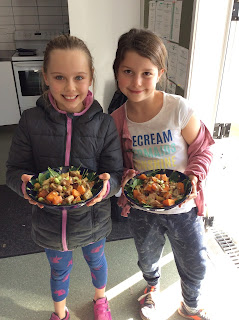Knife Skills
Written By Hannah Denton - our kitchen expert at garden to table
How to properly handle and use a knife is an important - and challenging - skill for kids to learn. As we progress with Garden to Table as part of our curriculum the kids skills will increase. This also means we can achieve more in each kitchen session.
To help your kids develop these skills - and to get them whipping up food in your own kitchen - here are some simple tips for fostering knife skills at home. These are tips recommended by Garden to Table ambassador Al Brown and skills we’ve begun fostering in the kitchen. We encourage you to experiment with your kiddos and see what works best for them!
Firstly, several key rules in the garden to table kitchen should also apply at home. We never let the kids use knives without adult permission and supervision. Because we have amazing help from volunteer parents, our kids work in groups of 3 or 4 kids per adult.
Stand at the right height
Kitchen counters are built so they are just the right height for most people. You want your kids to stand on a stool or chair that puts the counter at about waist height. They should be able to clearly see what they are cutting. At school we use trestle tables and benches in the technology room that are lower than normal kitchen counters.
Holding the knifeWe’ve seen in the kitchen there is no one way the kids hold the knife. Some of this is due to the strength they have in their wrists. However, there are few general rules to adhere to. You want the kids holding the knife in their dominant hand with the bulk of their fingers wrapped around the handle. The kids will usually rest a thumb or thumb and pointer finger on the top of the handle and blade.
It is important to ensure the fingers wrapped around the handle do not come forward to the blade.
Holding the produceWe have taught the kids two types of grip to hold their produce. The “claw grip” and the “bridge grip.”

Bridge GripSee if they can demonstrate these to you at home. We also explain to place the flat part of the produce on their chopping board to prevent the item rocking away. We’ve found this instruction needs constant reiterating as they forget to turn the produce over when they are excited.
For the claw grip, hold vegetables with the tips of your fingers resting on top of the vegetable and your thumb tucked behind the rest of your fingers. This is called a claw grip as your hand looks like a bear claw with the fingers tucked in so your knuckles are closest to the knife. This grip can be used with most types of produce.
For the bridge grip, you make a bridge with your thumb and fingers firmly pushing down on the produce. The knife then goes underneath your “bridge” so your hand is completely safe and cannot be cut. This grip may be difficult for younger children due to the size of their hands compared the knife, but is a good one to demonstrate and use for children with bigger hands.
Other considerations.
The kids are working towards their knife license. As well as showing proficiency with knife skills, they also need to demonstrate knife safety.
Part of using a knife safely is knowing how to walk around the kitchen and pass the knife. First, encourage your kids to always keep their hand on the handle and make sure the knife is never pointed at anybody – including themselves! When walking around the kitchen carry the knife down by your side with the point facing down to the floor. When passing a knife, makes sure the other person can grab the handle and does not need to touch the blade. It may be safer to put the knife down on the bench and let someone else pick it up.
To wash the knife we have explained to the kids to only put a knife into a sink of soapy water when they are able to wash it up immediately themselves. If they can’t do that straight away, leave the knife on the bench next to the sink in clear sight. A knife can be easily hidden in a sink of soapy water and someone could cut their hand on it if they don’t know it is there. When drying the knife, keep one hand on the handle, and wipe the blade with a tea towel, running your hand along the blunt side of the blade.
We hope these tips help you with the kids in the kitchen. We’re blown away with how their skills are progressing and their interest in cooking food. Be sure to check in to the Garden to Table blog as we will post photos and recipes of the kids growing, cooking and enjoying their kai.





















